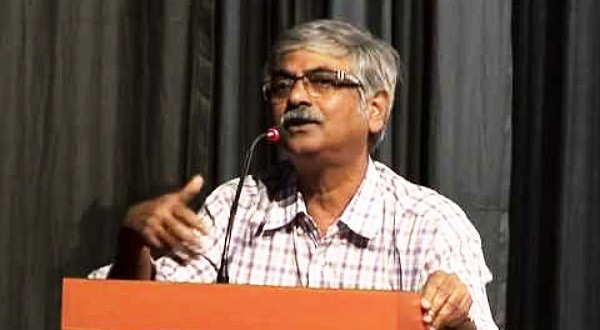(Emminent “commentateur culturel” of the Bengali cutural arena and retired Professor of Department of Film Studies, Jadavpur University, Kolkata, India)
I spoke to Sanjoy da sometime around March 2020. Our discourse spanned his life, education, politics, his existential perspectives, literature and off course cinema and Ritwik Ghatak. This excerpt pertains mainly to the portions of our “adda” on Ritwik and Sanjoy da's views expressed in his renowned book “Ritwiktantra”. To one of my initial questions of this interview Sanjoyda said:
“…I have to say this here that Ritwik’s commentaire in Jadavpur in 1968 made us gaze in awe at a renowned film-maker giving his lecture on cinema without uttering a single word on cinema itself. He primarily talked on history. We realized that one could discuss cinema in the context of history or talk history in the light of cinema. … Now, this process of subjective intervention of one discourse into another, this is intertextuality!
Rupak: Let me shift to the more visible side of yours. What is the motivation behind your monumental interest on Ritwik Ghatak?
Sanjoy: As I said, it felt to me that his films were trying to break the popular notions of cinema; that he is trying to write a thesis on the state of human existence. He was trying to study the connection between man and history! For example “Ajantrik” opened my thoughts and I realized that it was the first ever Bengali film to experiment by connecting the modern notion of automobiles with tribal existence. An inclusive history! You will notice that his characters have no homes, no addresses. Take Ajantrik's Bimal as an example. Leaving the idea of the new states of existence depicted in Subarnarekha or Meghe Dhaka Tara or Bari Theke Paliye aside, even Jukti-Tokko-Goppo showed his own Itinerancy as a traveler. Comparing his work to Antonioni, you will be able to see a grand unification of the Indian crisis of being physically uprooted with the European state of extreme alienation. Ritwik was able to universalize the fact of “homes disrupt evermore far and near, the sound of village-fall murmurs around'! Alike the Battle of Panipath, partition too has a mere historical importance to us, it is not tangible; that is where we need Ritwik's cinema. If you need to redefine what has already been defined then Ritwik can provide you a cerebral tool!
Rupak: One particular point In your book “Ritwiktantra” was of concern to me; I had written it in the review as well. It’s understandable that you were trying to show the creative evolution of director Ritwik independent of the influence of Godard; both being artists of the same psychic genre, if I may say so. But at certain places it seemed to me that you were trying to give Ritwik an irrational edge! Why was it so?
Sanjoy: Yes I know! ‘Why did I write that in comparison, Ritwik was the first to propose such novel cinematic approach?'- was your question, right? Actually, I was trying to defend a lost cause. Till then Ritwik was not discussed much. The discourse started in 1976 and he passed away within a couple of months. Whereas, by then, Godard was already much appreciated in the European circle and elsewhere. Even here, because of our colonial legacy! We are used to opening our umbrellas here even when it rains in Paris!(laughs) No one thought about Ritwik. I wanted to show that alike Godard, who was trying to analyze film as an audio-visual writing process, Ritwik Ghatak was also trying to represent a philosophical discourse through images.
Rupak: He himself had commented the same by comparing theater and cinema; saying that a drama can be read as literature which is difficult in the case of screenplay, right?
Sanjoy: Yes, you can read a drama even without watching it. But screenplay is like a skeleton. It’s difficult to comprehend without adding flesh and blood. In 1973-74 I translated Godard's “Masculin Feminine” and it got published in Jadavpur University Art and Literary Society's magazine. At that point Godard was not even a part of Kolkata's cultural space. So, why did I do it? Because, he tried to catch the mass discontent of contemporary Paris through the film. The love story had metamorphosed into such a news daily where at times flowers were blossoming and at times there were explosions!
Rupak: In an interview with Khosru saheb, Ritwik Ghatak once said, “…I said that Bergman is a fraud.” And to explain himself he said that unlike other directors who are analyzing the use of myth in cinema from a contemporary perspective, he is regressive! Do you agree with this statement?
Sanjoy: Let me share an anecdote here. Once Ritwik vehemently talked trash about Bergman in Hindusthan times. The day after it was published he was supposed to talk about one of Bergman's film. He started. Suddenly, P K Nayar, who later became the director of Pune Film Archive, raised his finger. Ritwikda used to get very angry with any disturbances during his lectures. He tried to ignore it, but Nayar was persistent. Ritwikda inquired, “yes Nayar?” Nayar answered, “ Sir, the other day you told that Bergman is an arch reactionary, and now you are saying that he is great. How can this be reconciled?”
Ritwik's banter in this context is pretty well-known; I heard it from Kumar Sahani.
He said, “That’s between me and Bergman. But for you, he is great!”(laugh)
We hear only a part of Ritwik's commentaries on Bergman. He actually was a great admirer and never thought of him as an ordinary cheat. On the contrary, he shares so many things with him. This is dissent out of admiration.
Rupak: My next question is about Ghatak's mother complex which he himself had ushered on numerous occasions. I am not sure if I can name it as the idea of “mythical motherhood”, but don’t you think there is a serious contradiction between the mother complex represented in “Jukti Tokko ar Goppo” or “Subarnarekha” and the conscious ongoing struggle between feminine duality and humanism evident in the backdrop of “Meghe Dhaka Tara”?
Sanjoy: Perhaps there is no contradiction, but a difference is certainly present. You might consider the cruel motherhood depicted by Gita Dey and the benevolent motherhood of Nita to be of complementary existence. What he wants to say is that you can't define femininity through a linear equation and pointing at ‘her' as – she is this! There is an incestuous game depicted through Sita being a mother in Subarnarekha. For instance, child Abhiram grazes in the shot where Sita is singing. Alike Pasolini's films or any other great art there are numerous similar areas which are beyond explanation. What he tried was to find a way of reaching feminine plentitude considering the gender as a symbol of incompleteness in context to our matriarchal civilization. At the same time Anusuya's motherhood in ‘Komol Gandhar' is so abstract that at times it gets difficult to acknowledge her as a tangible feminine character.
Contradiction in itself is a component of modernism. Modern art is never deterministic, it is probabilistic.
Rupak: I have two final questions. Firstly, will we Bengalis get our “film-director” Sanjoy Mukhopadhyay?
Sanjoy: Well that is something that me and Bengalis can mutually decide (laughs). But, as Rabindranath said in 1929, this not merely a relation between the creator and his creation, there is that important aspect of investment in between. Who will give me a few lakh or a few crore rupees? Unless this is reconciled yours is a tricky question. This is evidently not France or America, where, even keeping profit in mind, counter-culture can be sold over the counter! (laughs again) It is quite difficult to sell counter-culture here! Additionally, the way right wing politics is encircling us, I will have to keep this context incomplete at the moment…
Rupak: Do you currently have any long term literary projects at hand?
Sanjoy: Yes, alike Walter Benjamin's arcade projects, I mean the ones he started towards his last days in Paris, I am trying to conceptualize something similar on urban Kolkata in particular contexts like Jibananda Das. I think it might be a worthwhile work on our urban existence. And, I am trying to analyze, through my own perspective, the crisis of why suspense or detective stories have suddenly gained such popularity in Kolkata. I want to see the complete structure of our cultural modernism.
Rupak: My last question. Advise us, i.e. my generation with 5 films and 5 books which you find necessary in order to gain a holistic perspective on cinema and culture.
Sanjoy: The Brothers Karamazov, Idiot, Hamlet, Putul Nacher Itikotha, Sathti Tarar Timir, and Balaka. Well, I gave you six.
And for cinema: Subarnarekha, Through the Olive Trees, Modern Times, Psycho, Pierre le Fou, Silence and La Notte.
Powered by Froala Editor



